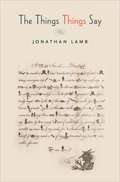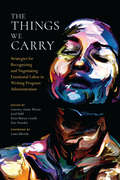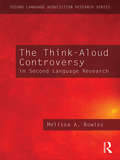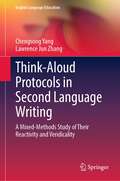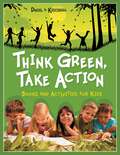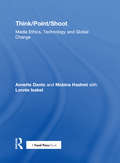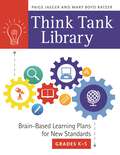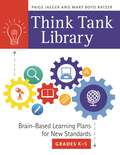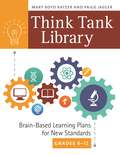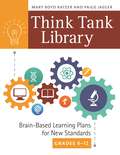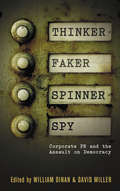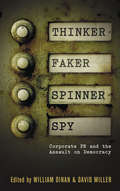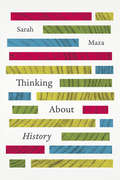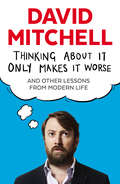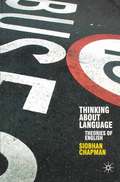- Table View
- List View
The Things Things Say
by Jonathan LambOne of the new forms of prose fiction that emerged in the eighteenth century was the first-person narrative told by things such as coins, coaches, clothes, animals, or insects. This is an ambitious new account of the context in which these "it narratives" became so popular. What does it mean when property declares independence of its owners and begins to move and speak? Jonathan Lamb addresses this and many other questions as he advances a new interpretation of these odd tales, from Defoe, Pope, Swift, Gay, and Sterne, to advertisements, still life paintings, and South Seas journals. Lamb emphasizes the subversive and even nonsensical quality of what things say; their interests are so radically different from ours that we either destroy or worship them. Existing outside systems of exchange and the priorities of civil society, things in fact advertise the dissident obscurity common to slave narratives all the way from Aesop and Phaedrus to Frederick Douglass and Primo Levi, a way of meaning only what is said, never saying what is meant. This is what Defoe's Roxana calls "the Sense of Things," and it is found in sounds, substances, and images rather than conventional signs.This major work illuminates not only "it narratives," but also eighteenth-century literature, the rise of the novel, and the genealogy of the slave narrative.
The Things We Carry: Strategies for Recognizing and Negotiating Emotional Labor in Writing Program Administration
by Courtney Adams Wooten Jacob Babb Kristi Murray Costello Kate NavickasEmotional labor is not adequately talked about or addressed by writing program administrators. The Things We Carry makes this often-invisible labor visible, demonstrates a variety of practical strategies to navigate it reflectively, and opens a path for further research. Particularly timely, this collection considers how writing program administrators work when their schools or regions experience crisis situations. The book is broken into three sections: one emphasizing the WPA’s own work identity, one on fostering community in writing programs, and one on balancing the professional and personal. Chapters written by a diverse range of authors in different institutional and WPA contexts examine the roles of WPAs in traumatic events, such as mass shootings and natural disasters, as well as the emotional labor WPAs perform on a daily basis, such as working with students who have been sexually assaulted or endured racist, sexist, homophobic, and otherwise disenfranchising interactions on campus. The central thread in this collection focuses on “preserving” by acknowledging that emotions are neither good nor bad and that they must be continually reflected upon as WPAs consider what to do with emotional labor and how to respond. Ultimately, this book argues for more visibility of the emotional labor WPAs perform and for WPAs to care for themselves even as they care for others. The Things We Carry extends conversations about WPA emotional labor and offers concrete and useful strategies for administrators working in both a large range of traumatic events as well as daily situations that require tactical work to preserve their sense of self and balance. It will be invaluable to writing program administrators specifically and of interest to other types of administrators as well as scholars in rhetoric and composition who are interested in emotion more broadly.
Think Again: How to Reason and Argue (Pelican Books)
by Walter Sinnott-ArmstrongA masterclass in persuasion from the inspiring philosopher who has taught a million people to argue through his popular open online courseOur personal and political worlds are rife with arguments and disagreements, some of them petty and vitriolic. The inability to compromise and understand the other side is widespread today. What can we do to change this? In Think Again philosopher Walter Sinnott-Armstrong draws on a long tradition of logic to show why we should stop focusing on winning arguments and instead argue in a more constructive way.Based on a hugely popular online course with more than a million followers around the world, Think Again explains how to analyse, evaluate and make better arguments while also spotting bad reasoning and avoiding certain fallacies. Through lively, practical examples from everyday life, politics and popular culture, Walter Sinnott-Armstrong offers brilliantly straightforward, wise advice that we can all use at work, at home and online.
The Think-Aloud Controversy in Second Language Research (Second Language Acquisition Research Series)
by Melissa A. BowlesThe Think-Aloud Controversy in Second Language Research aims to answer key questions about the validity and uses of think-alouds, verbal reports completed by research participants while they perform a task. It offers an overview of how think-alouds have been used in language research and presents a quantitative meta-analysis of findings from studies involving verbal tasks and think-alouds. The book begins by presenting the theoretical background and empirical research that has examined the reactivity of think-alouds, then offers guidance regarding the practical issues of data collection and analysis, and concludes with implications for the use of think-alouds in language research. With its focus on a much-discussed and somewhat controversial data elicitation method in language research, this timely work is relevant to students and researchers from all theoretical perspectives who collect first or second language data. It serves as a valuable guide for any language researcher who is considering using think-alouds.
The Think-Aloud Controversy in Second Language Research (Second Language Acquisition Research Series)
by Melissa A. BowlesThe Think-Aloud Controversy in Second Language Research aims to answer key questions about the validity and uses of think-alouds, verbal reports completed by research participants while they perform a task. It offers an overview of how think-alouds have been used in language research and presents a quantitative meta-analysis of findings from studies involving verbal tasks and think-alouds. The book begins by presenting the theoretical background and empirical research that has examined the reactivity of think-alouds, then offers guidance regarding the practical issues of data collection and analysis, and concludes with implications for the use of think-alouds in language research. With its focus on a much-discussed and somewhat controversial data elicitation method in language research, this timely work is relevant to students and researchers from all theoretical perspectives who collect first or second language data. It serves as a valuable guide for any language researcher who is considering using think-alouds.
Think-Aloud Protocols in Second Language Writing: A Mixed-Methods Study of Their Reactivity and Veridicality (English Language Education #34)
by Chengsong Yang Lawrence Jun ZhangThis book addresses the validity of think-aloud protocols (TAPs) in L2 writing research through a mixed methods study and proposes effective approaches for their valid implementation. The book uncovers the reactive effects that TAPs have on L2 writing performance and processes, and examines how individual factors moderate this reactivity. It further presents and categorizes participants' perceptions regarding reactivity and veridicality. To enhance veridicality, the book identifies incomplete TAPs using retrospective verbal reports as a reference point. Recommendations for utilizing TAPs include considering participants' individual differences, recent experiences, and emotions. This book will be valuable to educators teaching methodology in second or foreign language education, applied linguistics, or writing research, and to L2 researchers or graduate students with a broad interest in research methods, process-based research, or writing studies, or planning to incorporate TAPs into their research.
Think Green, Take Action: Books and Activities for Kids
by Daniel A. KriesbergThis book provides an annotated bibliography of age-appropriate literature and activities, showing children the importance of environmental issues and teaching them the skills to take action.In past years, teaching children about conservation and environmental issues might have been an optional side topic to complement an earth science curriculum, but in today's educational climate, "being green" is a subject with great relevance and importance.This book combines a wide variety of techniques to help students understand environmental issues and gain the skills needed to take action. The children's literature and classroom activities suggested in Think Green, Take Action: Books and Activities for Kids are appropriate for elementary school students from grades three through seven, covering three major environmental issues: endangered species, resource depletion, and pollution. After students have a grasp of the causes of these environmental problems, the final chapter presents ways to take easy action that can create ripples of change across the world. Educators in museums and nature centers, home-schooled children, and their parents comprise an appropriate secondary audience for this instructive text.
Think/Point/Shoot: Media Ethics, Technology and Global Change
by Annette Danto Mobina Hashmi Lonnie IsabelThink/Point/Shoot gives students a thorough overview of the role of ethics in modern media creation. Case studies emphasize the critical issues in global media ethics today in all stages of media creation from preproduction research and development, to production and post production. This volume features practicing filmmakers, journalists, and media creators who provide insight into dealing with real-world ethical dilemmas. For this era, digital imagery, sounds, and web communication have opened doors to sharing thoughts and ideas instantaneously to potentially vast audiences. This presents exciting opportunities, but also serious ethical, legal, and social challenges. The cases and exercises found in this book are applicable to the current media field while still remaining grounded in strong ethical theory. Think/Point/Shoot explains the challenge of communicating a story to a worldwide audience while maintaining ethical standards. A companion website provides additional resources for students and instructors: media ethics game chapter summaries and case studies important forms Instructors will also find: classroom exercises PowerPoints video from the "Global Media Ethics" Conference from March 2013
Think/Point/Shoot: Media Ethics, Technology and Global Change
by Annette Danto Mobina Hashmi Lonnie IsabelThink/Point/Shoot gives students a thorough overview of the role of ethics in modern media creation. Case studies emphasize the critical issues in global media ethics today in all stages of media creation from preproduction research and development, to production and post production. This volume features practicing filmmakers, journalists, and media creators who provide insight into dealing with real-world ethical dilemmas. For this era, digital imagery, sounds, and web communication have opened doors to sharing thoughts and ideas instantaneously to potentially vast audiences. This presents exciting opportunities, but also serious ethical, legal, and social challenges. The cases and exercises found in this book are applicable to the current media field while still remaining grounded in strong ethical theory. Think/Point/Shoot explains the challenge of communicating a story to a worldwide audience while maintaining ethical standards. A companion website provides additional resources for students and instructors: media ethics game chapter summaries and case studies important forms Instructors will also find: classroom exercises PowerPoints video from the "Global Media Ethics" Conference from March 2013
Think Tank Library: Brain-Based Learning Plans for New Standards, Grades K–5
by Paige Jaeger Mary Boyd RatzerTransform your library into a "think tank" by helping teachers create an active learning environment in which students question, investigate, synthesize, conclude, and present information based on Common Core standards.The rigors of today's mandated academic standards can repurpose your library's role as a steward of the Common Core State Standards (CCSS) at your school. This guide will help you help teachers present exciting, field-tested lessons for elementary grades K through 5, addressing developmental steps and individual differences in key competencies in the CCSS. Authors and educators Mary Ratzer and Paige Jaeger illustrate how brain-based learning helps students become deep, critical thinkers and provide the lesson plans to coax the best thinking out of each child.This tool book presents strategies to help learners progress from novice to expert thinker; challenge younger students with questions that lead to inquiry; incorporate "rigor" into lessons; and use model lesson plans to change instruction. Beginning chapters introduce the basics of instruction and provide ideas for expert cognitive growth of the brain. Sample lessons are aligned with key curriculum areas, including science, social studies, music, art, and physical education.
Think Tank Library: Brain-Based Learning Plans for New Standards, Grades K–5
by Paige Jaeger Mary Boyd RatzerTransform your library into a "think tank" by helping teachers create an active learning environment in which students question, investigate, synthesize, conclude, and present information based on Common Core standards.The rigors of today's mandated academic standards can repurpose your library's role as a steward of the Common Core State Standards (CCSS) at your school. This guide will help you help teachers present exciting, field-tested lessons for elementary grades K through 5, addressing developmental steps and individual differences in key competencies in the CCSS. Authors and educators Mary Ratzer and Paige Jaeger illustrate how brain-based learning helps students become deep, critical thinkers and provide the lesson plans to coax the best thinking out of each child.This tool book presents strategies to help learners progress from novice to expert thinker; challenge younger students with questions that lead to inquiry; incorporate "rigor" into lessons; and use model lesson plans to change instruction. Beginning chapters introduce the basics of instruction and provide ideas for expert cognitive growth of the brain. Sample lessons are aligned with key curriculum areas, including science, social studies, music, art, and physical education.
Think Tank Library: Brain-Based Learning Plans for New Standards, Grades 6–12
by Mary Boyd Ratzer Paige JaegerTransform your library into a "think tank" by helping teachers create an active learning environment in which students question, investigate, synthesize, conclude, and present information based on Common Core standards.The rigors of today's mandated academic standards can repurpose your library's role as a steward of the Common Core State Standards (CCSS) at your school. Created for teachers of grades 6 through 12, this guide will help you help present exciting, field-tested lessons that address developmental steps and individual differences in key competencies in the CCSS. Authors and educators Mary Ratzer and Paige Jaeger illustrate how brain-based learning helps students become deep, critical thinkers, and provide the lesson plans to coax the best thinking out of each child.This tool book presents strategies to help learners progress from novice to expert thinker; challenge students with questions that lead to inquiry; incorporate "rigor" into lessons; and use model lesson plans to change instruction. Beginning chapters introduce the basics of instruction and provide ideas for expert cognitive growth of the brain. Sample lessons are aligned with key curriculum areas, including science, social studies, music, art, and physical education.
Think Tank Library: Brain-Based Learning Plans for New Standards, Grades 6–12
by Mary Boyd Ratzer Paige JaegerTransform your library into a "think tank" by helping teachers create an active learning environment in which students question, investigate, synthesize, conclude, and present information based on Common Core standards.The rigors of today's mandated academic standards can repurpose your library's role as a steward of the Common Core State Standards (CCSS) at your school. Created for teachers of grades 6 through 12, this guide will help you help present exciting, field-tested lessons that address developmental steps and individual differences in key competencies in the CCSS. Authors and educators Mary Ratzer and Paige Jaeger illustrate how brain-based learning helps students become deep, critical thinkers, and provide the lesson plans to coax the best thinking out of each child.This tool book presents strategies to help learners progress from novice to expert thinker; challenge students with questions that lead to inquiry; incorporate "rigor" into lessons; and use model lesson plans to change instruction. Beginning chapters introduce the basics of instruction and provide ideas for expert cognitive growth of the brain. Sample lessons are aligned with key curriculum areas, including science, social studies, music, art, and physical education.
Think to New Worlds: The Cultural History of Charles Fort and His Followers
by Joshua Blu BuhsHow a writer who investigated scientific anomalies inspired a factious movement and made a lasting impact on American culture. Flying saucers. Bigfoot. Frogs raining from the sky. Such phenomena fascinated Charles Fort, the maverick writer who scanned newspapers, journals, and magazines for reports of bizarre occurrences: dogs that talked, vampires, strange visions in the sky, and paranormal activity. His books of anomalies advanced a philosophy that saw science as a small part of a larger system in which truth and falsehood continually transformed into one another. His work found a ragged following of skeptics who questioned not only science but the press, medicine, and politics. Though their worldviews varied, they shared compelling questions about genius, reality, and authority. At the center of this community was adman, writer, and enfant terrible Tiffany Thayer, who founded the Fortean Society and ran it for almost three decades, collecting and reporting on every manner of oddity and conspiracy. In Think to New Worlds, Joshua Blu Buhs argues that the Fortean effect on modern culture is deeper than you think. Fort’s descendants provided tools to expand the imagination, explore the social order, and demonstrate how power is exercised. Science fiction writers put these ideas to work as they sought to uncover the hidden structures undergirding reality. Avant-garde modernists—including the authors William Gaddis, Henry Miller, and Ezra Pound, as well as Surrealist visual artists—were inspired by Fort’s writing about metaphysical and historical forces. And in the years following World War II, flying saucer enthusiasts convinced of alien life raised questions about who controlled the universe. Buhs’s meticulous and entertaining book takes a respectful look at a cast of oddballs and eccentrics, plucking them from history’s margins and spotlighting their mark on American modernism. Think to New Worlds is a timely consideration of a group united not only by conspiracies and mistrust of science but by their place in an ever-expanding universe rich with unexplained occurrences and visionary possibilities.
Think to New Worlds: The Cultural History of Charles Fort and His Followers
by Joshua Blu BuhsHow a writer who investigated scientific anomalies inspired a factious movement and made a lasting impact on American culture. Flying saucers. Bigfoot. Frogs raining from the sky. Such phenomena fascinated Charles Fort, the maverick writer who scanned newspapers, journals, and magazines for reports of bizarre occurrences: dogs that talked, vampires, strange visions in the sky, and paranormal activity. His books of anomalies advanced a philosophy that saw science as a small part of a larger system in which truth and falsehood continually transformed into one another. His work found a ragged following of skeptics who questioned not only science but the press, medicine, and politics. Though their worldviews varied, they shared compelling questions about genius, reality, and authority. At the center of this community was adman, writer, and enfant terrible Tiffany Thayer, who founded the Fortean Society and ran it for almost three decades, collecting and reporting on every manner of oddity and conspiracy. In Think to New Worlds, Joshua Blu Buhs argues that the Fortean effect on modern culture is deeper than you think. Fort’s descendants provided tools to expand the imagination, explore the social order, and demonstrate how power is exercised. Science fiction writers put these ideas to work as they sought to uncover the hidden structures undergirding reality. Avant-garde modernists—including the authors William Gaddis, Henry Miller, and Ezra Pound, as well as Surrealist visual artists—were inspired by Fort’s writing about metaphysical and historical forces. And in the years following World War II, flying saucer enthusiasts convinced of alien life raised questions about who controlled the universe. Buhs’s meticulous and entertaining book takes a respectful look at a cast of oddballs and eccentrics, plucking them from history’s margins and spotlighting their mark on American modernism. Think to New Worlds is a timely consideration of a group united not only by conspiracies and mistrust of science but by their place in an ever-expanding universe rich with unexplained occurrences and visionary possibilities.
Thinker, Faker, Spinner, Spy: Corporate PR and the Assault on Democracy
by David Miller William DinanThe public relations industry is not just about celebrity gossip. This book shows how, whenever big business is threatened, spin doctors, lobbyists, think tanks and front groups are on hand to push the corporate interest, often at the public's expense. *BR**BR*Written by leading activists and writers, this book reveals the secrets of the PR trade including deception, the use of fake 'institutes', spying and dirty tricks. The impact can be devastating -- when the public is denied access to the truth, the results are rising inequality and environmental catastrophe. *BR**BR*Exposing the misdeeds of famous companies including Coca Cola, British Aerospace, Exxon and Monsanto, and revealing information about the covert funding of various apparently independent thinks tanks and institutes, the authors offer a guide to campaigns that can help us roll back corporate power and resist deceptive PR.
Thinker, Faker, Spinner, Spy: Corporate PR and the Assault on Democracy
by David Miller William DinanThe public relations industry is not just about celebrity gossip. This book shows how, whenever big business is threatened, spin doctors, lobbyists, think tanks and front groups are on hand to push the corporate interest, often at the public's expense. *BR**BR*Written by leading activists and writers, this book reveals the secrets of the PR trade including deception, the use of fake 'institutes', spying and dirty tricks. The impact can be devastating -- when the public is denied access to the truth, the results are rising inequality and environmental catastrophe. *BR**BR*Exposing the misdeeds of famous companies including Coca Cola, British Aerospace, Exxon and Monsanto, and revealing information about the covert funding of various apparently independent thinks tanks and institutes, the authors offer a guide to campaigns that can help us roll back corporate power and resist deceptive PR.
Thinking About History
by Sarah MazaWhat distinguishes history as a discipline from other fields of study? That's the animating question of Sarah Maza’s Thinking About History, a general introduction to the field of history that revels in its eclecticism and highlights the inherent tensions and controversies that shape it. Designed for the classroom, Thinking About History is organized around big questions: Whose history do we write, and how does that affect what stories get told and how they are told? How did we come to view the nation as the inevitable context for history, and what happens when we move outside those boundaries? What is the relation among popular, academic, and public history, and how should we evaluate sources? What is the difference between description and interpretation, and how do we balance them? Maza provides choice examples in place of definitive answers, and the result is a book that will spark classroom discussion and offer students a view of history as a vibrant, ever-changing field of inquiry that is thoroughly relevant to our daily lives.
Thinking About History
by Sarah MazaWhat distinguishes history as a discipline from other fields of study? That's the animating question of Sarah Maza’s Thinking About History, a general introduction to the field of history that revels in its eclecticism and highlights the inherent tensions and controversies that shape it. Designed for the classroom, Thinking About History is organized around big questions: Whose history do we write, and how does that affect what stories get told and how they are told? How did we come to view the nation as the inevitable context for history, and what happens when we move outside those boundaries? What is the relation among popular, academic, and public history, and how should we evaluate sources? What is the difference between description and interpretation, and how do we balance them? Maza provides choice examples in place of definitive answers, and the result is a book that will spark classroom discussion and offer students a view of history as a vibrant, ever-changing field of inquiry that is thoroughly relevant to our daily lives.
Thinking About History
by Sarah MazaWhat distinguishes history as a discipline from other fields of study? That's the animating question of Sarah Maza’s Thinking About History, a general introduction to the field of history that revels in its eclecticism and highlights the inherent tensions and controversies that shape it. Designed for the classroom, Thinking About History is organized around big questions: Whose history do we write, and how does that affect what stories get told and how they are told? How did we come to view the nation as the inevitable context for history, and what happens when we move outside those boundaries? What is the relation among popular, academic, and public history, and how should we evaluate sources? What is the difference between description and interpretation, and how do we balance them? Maza provides choice examples in place of definitive answers, and the result is a book that will spark classroom discussion and offer students a view of history as a vibrant, ever-changing field of inquiry that is thoroughly relevant to our daily lives.
Thinking About History
by Sarah MazaWhat distinguishes history as a discipline from other fields of study? That's the animating question of Sarah Maza’s Thinking About History, a general introduction to the field of history that revels in its eclecticism and highlights the inherent tensions and controversies that shape it. Designed for the classroom, Thinking About History is organized around big questions: Whose history do we write, and how does that affect what stories get told and how they are told? How did we come to view the nation as the inevitable context for history, and what happens when we move outside those boundaries? What is the relation among popular, academic, and public history, and how should we evaluate sources? What is the difference between description and interpretation, and how do we balance them? Maza provides choice examples in place of definitive answers, and the result is a book that will spark classroom discussion and offer students a view of history as a vibrant, ever-changing field of inquiry that is thoroughly relevant to our daily lives.
Thinking About History
by Sarah MazaWhat distinguishes history as a discipline from other fields of study? That's the animating question of Sarah Maza’s Thinking About History, a general introduction to the field of history that revels in its eclecticism and highlights the inherent tensions and controversies that shape it. Designed for the classroom, Thinking About History is organized around big questions: Whose history do we write, and how does that affect what stories get told and how they are told? How did we come to view the nation as the inevitable context for history, and what happens when we move outside those boundaries? What is the relation among popular, academic, and public history, and how should we evaluate sources? What is the difference between description and interpretation, and how do we balance them? Maza provides choice examples in place of definitive answers, and the result is a book that will spark classroom discussion and offer students a view of history as a vibrant, ever-changing field of inquiry that is thoroughly relevant to our daily lives.
Thinking About History
by Sarah MazaWhat distinguishes history as a discipline from other fields of study? That's the animating question of Sarah Maza’s Thinking About History, a general introduction to the field of history that revels in its eclecticism and highlights the inherent tensions and controversies that shape it. Designed for the classroom, Thinking About History is organized around big questions: Whose history do we write, and how does that affect what stories get told and how they are told? How did we come to view the nation as the inevitable context for history, and what happens when we move outside those boundaries? What is the relation among popular, academic, and public history, and how should we evaluate sources? What is the difference between description and interpretation, and how do we balance them? Maza provides choice examples in place of definitive answers, and the result is a book that will spark classroom discussion and offer students a view of history as a vibrant, ever-changing field of inquiry that is thoroughly relevant to our daily lives.
Thinking About It Only Makes It Worse: And Other Lessons from Modern Life
by David MitchellTHE SUNDAY TIMES-BESTSELLING BOOK BY ONE OF BRITAIN'S BEST-LOVED COMIC WRITERS**Pre-order now: David Mitchell's new book Dishonesty is the Second-best Policy**There are many aspects of modern life that trouble award-winning comedian David Mitchell, such as: Why is every film or TV programme a sequel or a remake? Why are people so f***ing hung up about swearing? Why do the asterisks in that sentence make it ok? Why do so many people want to stop other people doing things, and how can they be stopped from stopping them?Join Mitchell on a tour of the absurdities of our times - from Ryanair to Richard III, Downton Abbey to phone etiquette, UKIP to hotdogs made of cats. Funny, provocative and shot through with refreshing amounts of common sense, Thinking About It Only Makes It Worse celebrates and commiserates on the state of things in our not entirely glorious modern world.'Mitchell is an exceptionally clever, eloquent and spot-on commentator. We should be grateful for him.' Daily Mail, Books of the Year
Thinking About Language: Theories Of English (PDF)
by Siobhan ChapmanThinking about Language encourages students to begin thinking about ways of seeing language and introduces past debates and current disputes on the way that human language works. The second half of the book explores some of the specific questions addressed by theorists, and the implications of different types of linguistic theory for the answers they have suggested. Chapman offers a balance between theory and application and provides an interesting and accessible introduction to the history of linguistic theory, the variety of different theoretical approaches to language study, and to the current state of the subject.
